Oregon Job Vacancies: Hiring in 2023 Slowed After Record High Levels in 2022
February 29, 2024Oregon employers reported 72,800 job openings at any given time in 2023. This is a 30% decline from the record high of 104,000 vacancies seen in Oregon in 2022. Prior to 2021, the highest level of job vacancies previously seen in Oregon was 60,700 vacancies in 2017.
The volume of vacancies in 2023 exceeded pre-pandemic levels, but some of the characteristics Oregon employers were looking for didn’t change much during the pandemic recession and recovery. A typical job vacancy tended to be for a full-time, permanent position.
2023 represented a significant slow down in hiring from the rapid jobs recovery seen in 2021 and 2022 and showed up in several ways in the job vacancy survey. It took less time to hire in 2023, with 25% of job vacancies open longer than 60 days. In 2021 and 2022, about two-thirds of job vacancies were open longer than 60 days. As the expansion slowed down after two years of rapid hiring, it also became less difficult for employers to fill their job openings. In 2023, employers reported difficulty filling 61% of vacancies, as opposed to 72% in 2021 and 2022.
Nearly two fifths of job vacancies (39%) required education beyond high school. This was the highest amount of job vacancies requiring education beyond high school since 2019 (34%). During the intense job recovery in 2021 and 2022, only about 30% of job vacancies required education beyond high school.
Another significant change from 2021 and 2022 was the percentage of job vacancies requiring previous experience. In 2023, 58% of job vacancies required some amount of previous experience. In 2021 and 2022, this was only a little over 50%.
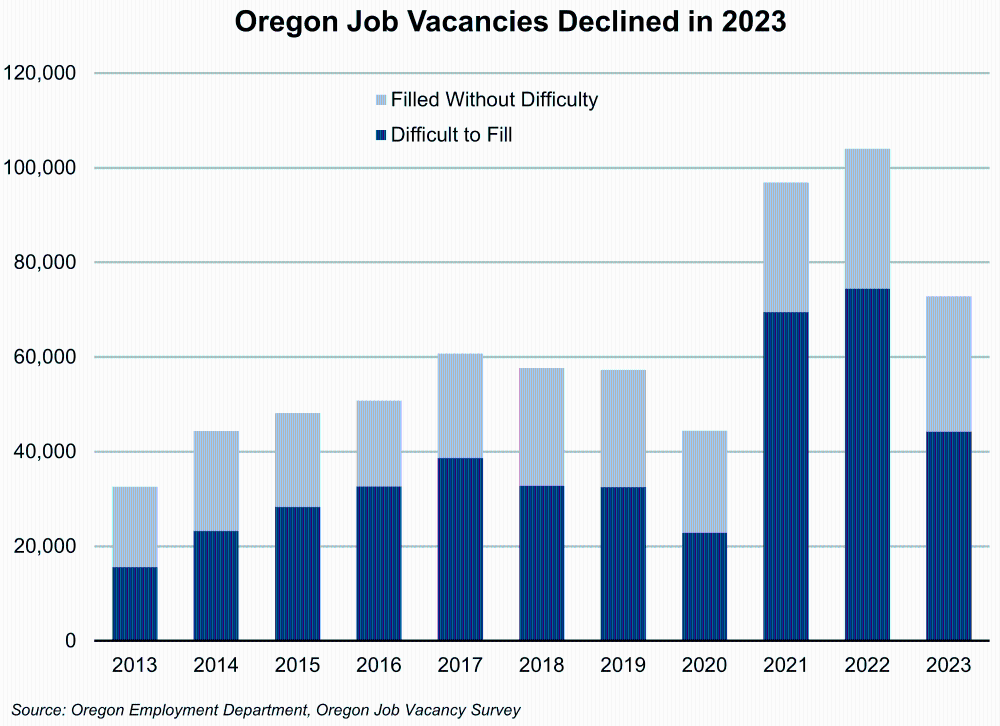
Throughout the year, the Oregon Employment Department surveys private employers from all industries and areas of the state to ask about job vacancies they are actively trying to fill. For each vacancy, the employer provides the job title, starting wage, and education and experience requirements for the job. They also specify whether their vacancies are for full- or part-time positions, and permanent or seasonal jobs. If they face challenges with vacancies, employers also write in the primary reason for difficulty filling their job openings.
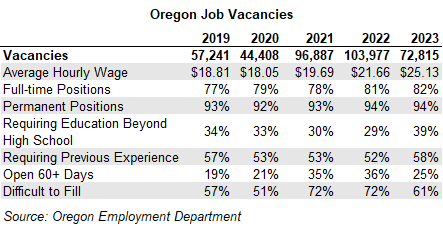
In 2023, health care and social assistance reported the most vacancies of any industry (19,500), twice as many vacancies has the next highest industry, leisure and hospitality (8,100). These two sectors were followed by management, administrative, and waste services (7,600), retail trade (6,400), and manufacturing (6,300). Together, these five sectors accounted for two thirds of all the job vacancies in Oregon in 2023. All industries reported at least 1,000 vacancies, except for private educational services (690).
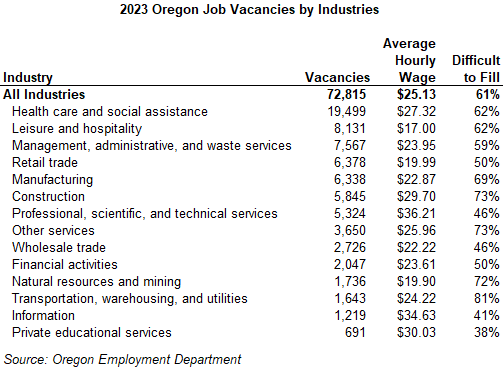
Employers were hiring for a wide variety of jobs; they reported vacancies across 380 different occupations. Top occupations across the economy included personal care aides (2,700); retail salespersons (2,600); heavy truck drivers (1,800); nursing assistants (1,700); registered nurses (1,600); and customer service representatives (1,600).
Full-Time and Permanent Help Wanted
Across all industries, most job vacancies (82%) offered full-time employment in 2023. That share rose as high as 98% in construction and 93% in financial activities, transportation, warehousing, and utilities, and wholesale trade. Leisure and hospitality had a low share compared with the average, at 57% full-time. Restaurant cooks, fast food and counter workers, maids and housekeeping cleaners, and waiters and waitresses had the most openings in leisure and hospitality, but many of these positions were not full time. In every other sector, at least seven out of 10 job openings were for full-time work.
Almost two-fifth (39%) of job vacancies require education beyond high school. That varied widely among industries. While more than half of professional scientific, and technical services (85%), private educational services (74%), health care and social assistance (58%), other services (55%), and transportation warehouses and utilities (50%) job openings required higher education, few openings among leisure and hospitality (6%), retail trade (13%), and natural resources and mining (15%) vacancies required education beyond high school.
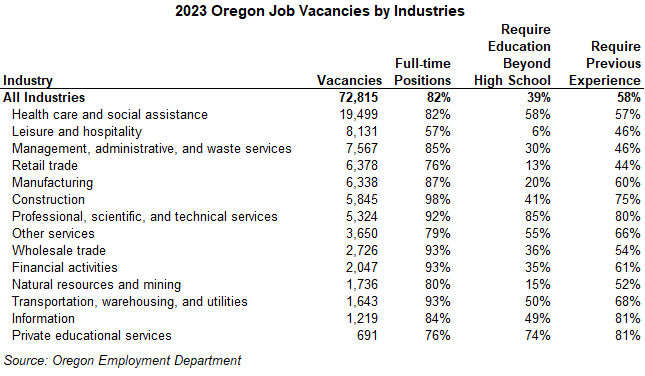
More Education, More Experience, and Higher Wages
As education requirements rose, so did the average starting wage for job openings. Job vacancies with no education requirement averaged $19.51 per hour in 2023. That rose to $19.83 for job vacancies requiring a high school diploma. Employers offered an average of $32.54 per hour for jobs with either some college, an associate degree, or a special certification beyond high school. Vacancies with bachelor’s or advanced degree requirements paid even more per hour, averaging $37.04.
Shares of job vacancies requiring previous experience also rose along with education requirements. While 44% of job vacancies with no education requirement reported a need for previous experience, almost two-thirds (60%) with a high school diploma wanted seasoned candidates. That grew to 76% of job vacancies where applicants needed postsecondary or other certifications. Nearly all (94%) job openings at the bachelor’s and advanced degree level required previous work experience.
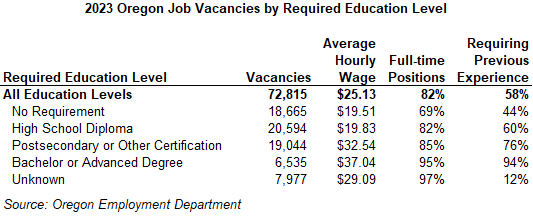
Summary
The rapid hiring seen in Oregon in 2021 and 2022 slowed in 2023. However, there were still higher levels of job vacancies in 2023 compared to before the pandemic in 2020. Employers faced less difficulty filling positions in 2023 and job openings stayed open for less time than in 2021 and 2022. Requirements for job vacancies increased in 2023, with more Oregon vacancies requiring previous experience and education beyond high school. Most job vacancies offered full-time work schedules, and employers were mostly looking to fill permanent positions. Vacancies with higher education requirements also came along with a greater likelihood for prior experience requirements, and higher average wages.
More information about regional and statewide job vacancies can be found in the Job Vacancy Survey section on the publications page of QualityInfo.org.